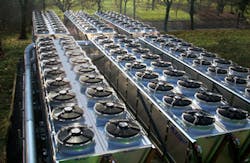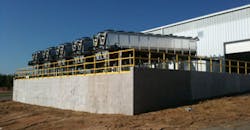Getting Ahead of the Curve: Advancements in Technology Signify Closed-Loop Systems for Cost-Effective, Eco-Friendly Process Cooling
By Al Fosco
Despite the movement to reduce and recycle water, many industrial companies in the United States with water-intensive processes are still stuck on the concept of using cooling towers for process cooling. But adhering to an inefficient, costly and wasteful practice of using cooling towers is far from a best practice. And the use of antiquated technology is rarely good for business.
The better strategy is to get ahead of the curve. All it takes is knowledge of the trends that drive the need for change. The decision to look at better alternatives also becomes clear when considering the latest advances in closed-loop process cooling systems. Here's what you need to know to move forward with a smarter approach to process cooling.
An Attractive Alternative
A closed-loop process cooling system uses ambient air to cool process water. The technology is a proven water- and energy-saving alternative to traditional cooling towers, which many U.S. companies use for process cooling.
The operation of closed-loop systems is straightforward. A system known as Ecodry, for example, features a central cooler that provides clean water at the right temperature to processes year- round. It uses heat exchangers and an internationally-patented adiabatic chamber to cool water circulated to it from process machines.
In the adiabatic chamber, a fine mist of water is pulsed into the incoming air stream during high ambient temperature conditions. The mist evaporates instantly, cooling the air before it impinges on the cooling coils that carry the process water. The process drops the temperature at or below the setpoint. Cooled water is then recirculated to a facility's process machines. The microprocessor-based controller automatically maintains targeted cooling temperatures.
A closed-loop system is an attractive alternative to cooling towers because it reuses water, which results in cost savings. A cooling tower, conversely, is an open-loop system that does not reuse water. The result is water waste in the form of evaporation. A closed-loop system also provides a number of ecological benefits when compared with cooling towers, including the absence of water contamination that threatens to spawn airborne diseases, such as Legionella. Another advantage over cooling towers is cost savings associated with significantly reduced maintenance and minimization of water treatment chemicals.
Closed-loop systems have proven themselves for years in Europe where water restrictions are limiting. It's only a matter of time before more companies in the U.S. adopt the technology as a number of trends drive the need for change.
Change Is in the Air
The reason many U.S. operations haven't considered alternatives to cooling towers for process cooling is because not all are concerned about water shortages. The issue is only a concern for companies where water is in short supply. Yet change is inevitable given a variety of factors that will eventually impact operations in all regions. They include:
- Heightened focus on energy savings: Companies continue to look for ways to conserve energy. The most diligent ones will find it by reducing the amount of water used in process cooling. That's because water requires significant energy input for treatment, pumping and process uses. Conserving water with a closed-loop system translates to tangible and often significant energy savings for a host of reasons. Depending on the geographic location, a closed-loop system uses ambient air to cool water during the winter months. As such, a company can shut off its chillers and capitalize on the closed-loop system's capability of "free cooling." In addition, newer systems incorporate highly-efficient fans and pumps. A closed-loop system also protects the heat exchangers from scaling, which can occur with older, open-loop systems. Less scaling results in higher energy efficiency.
- Customer preference for suppliers who are eco-conscious: Increasingly, customers of most companies prefer to work with suppliers who are strongly eco-conscious. Many look favorably on those who have earned ISO 14000 certification, which helps organizations minimize how their operations negatively affect the environment. A technically-advanced closed-loop process cooling system can play an important role in the ISO 14000 certification process, while separating a company from its competition.
- Being "green," not just saying it: Many companies promote their commitment to sustainability given the increasingly intense focus on the "green" movement. A newer closed-loop system that conserves resources at a higher level and delivers the best possible ecological benefits demonstrates that actions speak louder than words.
- Legislative momentum for water conservation: The federal government is actively pushing the need for water efficiency, including mandates for water conservation at federally-operated facilities. A closed-loop process cooling system can help make a potential issue a non-issue when legislators choose to look at measures elsewhere to protect precious water resources.
Process Cooling That Aligns with Goals
While the pace of change is slow, a growing number of companies are weighing the value of closed-loop process cooling systems. Many have also begun to take notice of newer systems that can be more readily configured to match their goals, whether it's improved sustainability, higher energy savings and/or reduced maintenance.
A closed-loop system's configurability stems largely from new options and enhancements associated with the technology's central cooler, which is at the heart of a closed-loop system.
For example, central coolers can be configured with fan exhaust diffusers to address the need for energy savings, not to mention noise abatement and reduction of outdoor land requirements. Located at the top of the cooler, the diffusers keep warm exhaust air from being drawn into the adiabatic chamber at the bottom of the unit. Further, these fans require as much as 21 percent less energy when compared with central coolers in years past.
A configurable central cooler also affords the ability to focus on targeted process cooling temperatures, regardless of the climate where the operation is located.
In the hottest climates, Frigel, a provider of advanced process cooling technology, for example, can design a central cooler with patent-pending technology that it refers to as an "adiabatic booster system." The system provides a boost of additional water within the unit to deliver cooling tower-type temperatures in these warmer environments. Yet companies can still save as much as 95 percent of process cooling water when compared with open-looped systems because it recirculates the additional water back into the adiabatic chamber. The totally enclosed system also eliminates potential maintenance issues associated with water scaling on heat exchangers or dangerous biological emissions.
In milder climates, there is no need for the booster system. As such, the central cooler can be designed with various heat exchanger configurations for improved temperature control. For operation in freezing climates, it can be configured with self-draining coils and recirculation pump stations to deliver optimum performance for systems that do not use glycol as a coolant.
While virtually all operations need a system designed around the company's goals and the issues specific to each plant location, another common issue they share is space constraints -- a concern that is readily addressed with a configurable central cooler.
To save space, a central cooler can be designed with the fan exhaust diffusers to allow multiple units to be positioned more closely together since air is no longer drawn into the bottom of the units. Roof panels serve the same purpose when a system is configured without air diffusers. Another option is to configure the unit with extended legs to facilitate airflow in tight spaces. The result is a footprint as much as 30 percent smaller than the previous generation coolers, depending on the configuration.
Necessity Drives Change
While necessity is the mother of invention, it might also be said that necessity drives change, especially when it comes to the need to curb water consumption. Companies who make water efficiency, energy savings and the environment a priority will achieve success by looking to the future -- and closely considering closed-loop systems instead of cooling towers for process cooling, whether it's for a plant expansion, replacement of aging equipment or a new facility.
About the Author: Al Fosco is the global marketing manager for Frigel, North America. Prior to joining Frigel in 2009, Fosco spent 16 years with Conair's Water Products Division, holding sales and engineering management positions, including VP of sales and marketing and general manager of engineering. Prior to that, he spent 14 years in engineering and sales management at AEC. He has a master's degree in Heat Transfer and Fluid Mechanics Engineering from the University of Illinois.


